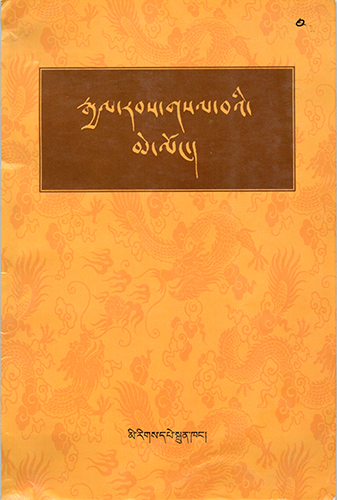Tag: BL Central Asia
(Open Access) KĀRAWĀN- Afghanistan Newspaper Digitized by University of Nebraska Libraries
Since the US invasion of Afghanistan, we continue to hear about the success of US policies when it comes to the nation-building in a war-torn land. We also continue hearing the ongoing violence in the country, and how we are winning the war. Policies aside, I personally support and stand by our American troops our soldiers overseas!
We rarely hear about the projects that lead to a sort of cultural memory preservation or often these are relegated to backstage. And our homeland is a major sponsor of such projects overseas. Domestically, public institutions of higher education continue to perform miracles by offering more and more digitized resources. Open Access matters!
Karawan is indeed a breath of fresh air in the OA domain. The University of Nebraska has digitized its issues. That can be accessed here.
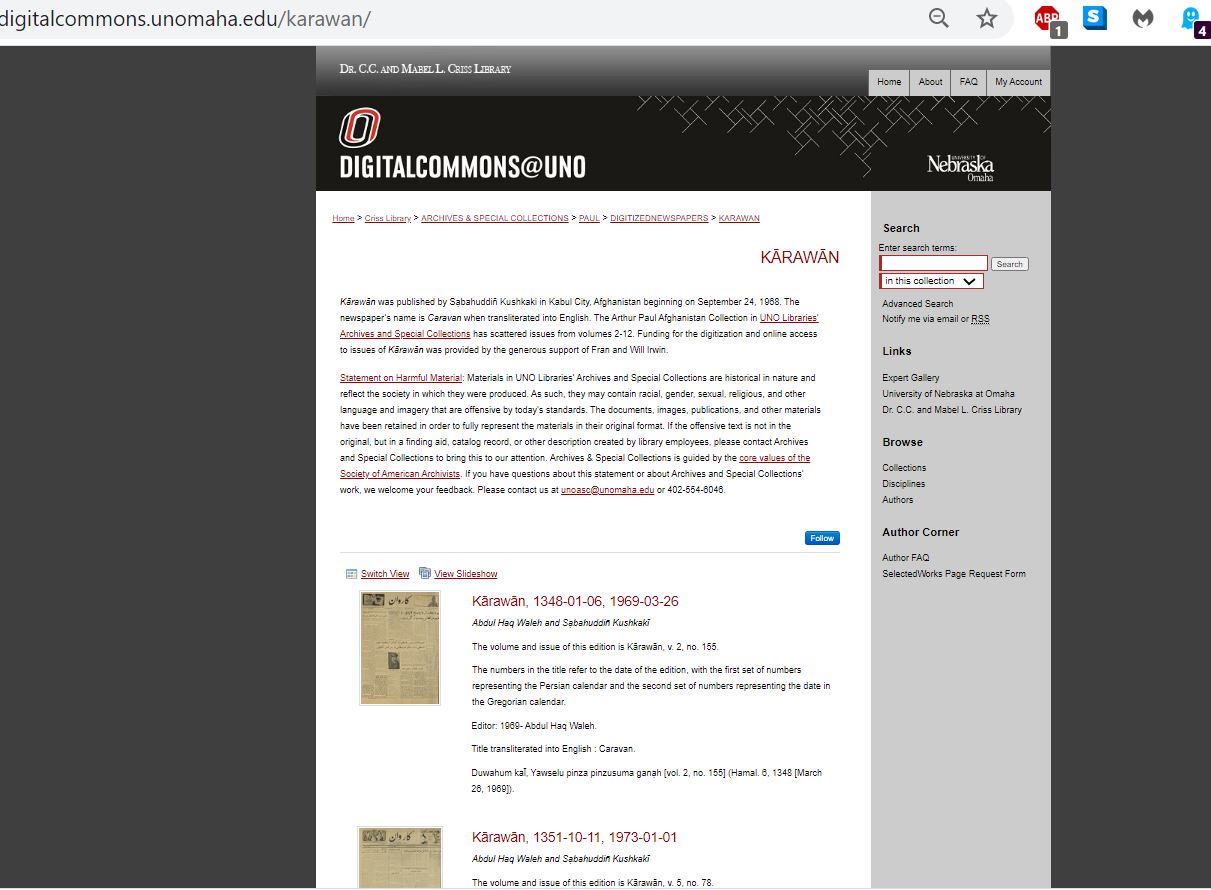
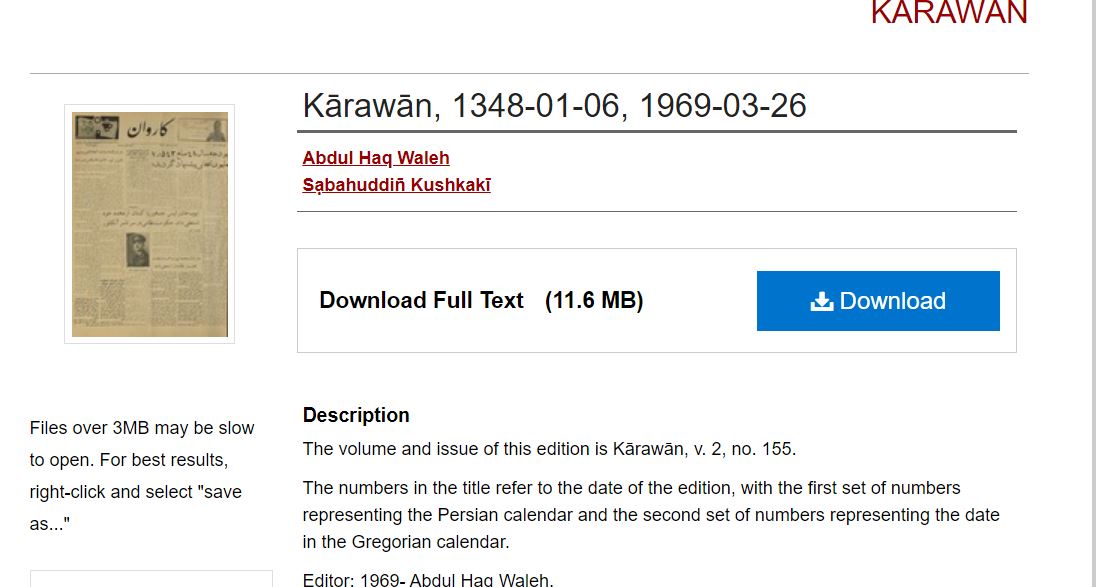
The site-description states that it was established by Sạbahuddin̄ Kushkakī (not to be confused with Burhanuddin Kushkaki) on 24 September 1968. Who was Sạbahuddin̄ Kushkakī is the question to which the answer cannot be simple? The US National Security Archive at GW University provides some insight on him in the context of National Endowment for Democracy (NED). A document entitled Afghanistan Democratic Education Project is informative of the early US efforts to carry out democratic goodwill projects. One can also find more information about him through the FOIA releases here (page.3) I will not dwell upon the trajectory of “the American Friends of Afghanistan, as one can read into who could have been its executive director at one point: z.k.”
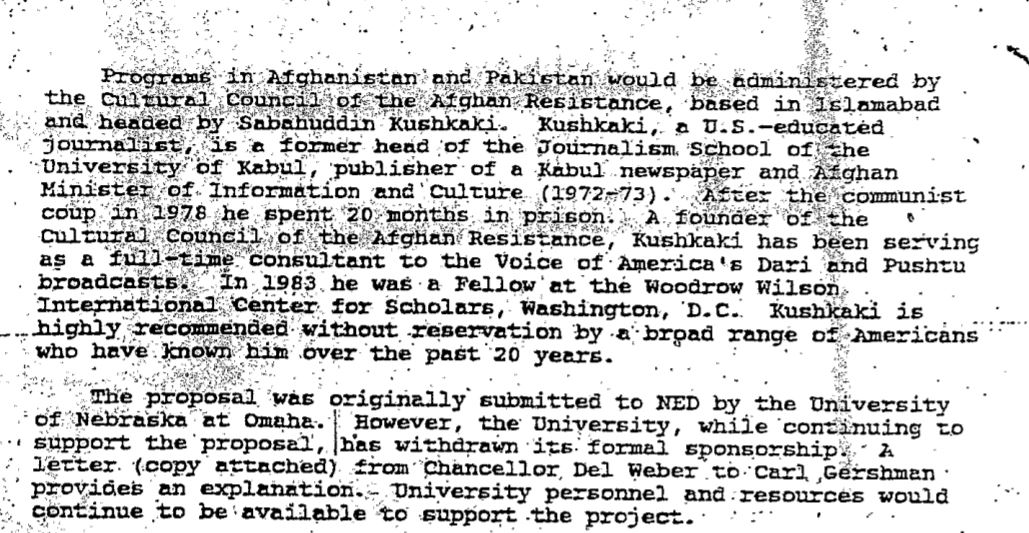
The point here is that due to these policies we have an effect of unintended consequences– we have access to Karawan!
Russian
The Languages of Berkeley: An Online Exhibition
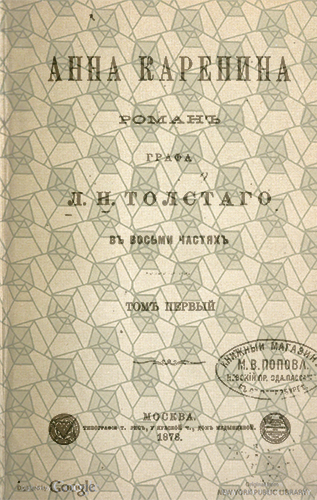
Leo Tolstoy’s literary work Anna Karenina first appeared as a series in the Russian journal Russkii Vestnik from 1873 through 1877.[1] It was published in Moscow in its book form in 1878. Considered the supreme masterpiece of realist fiction, Vladimir Nabokov called Anna Karenina “one of the greatest love stories in world literature.” Matthew Arnold claimed it was not so much a work of art as “a piece of life.” Set in imperial Russia, Anna Karenina is a vibrant and complex meditation on passionate love and disastrous infidelity. It is also a work of exquisite patterning, draped around the stories of two protagonists who meet only once in the course of the text. The first English edition was published in 1886 in New York by Thomas J. Crowell & Co and translated by Nathan Haskell Dole.
The Slavic collections at the UC Berkeley Library represent a significant treasure trove of material, the product of a century and a half of devoted, attentive collecting. The Library’s Slavic collection is easily the strongest on the West coast, and, indeed, Berkeley probably takes a back seat in this area only to Harvard’s Widener Library and the Library of Congress.
Russian has been taught at Berkeley since 1901, and The Slavic Department has been in existence for over a century. Berkeley was the location of the founding of the first chapter of Dobro Slovo, a national honor society for students of Slavic Languages. The Department has been fortunate to be the home of many exceptional scholars, including Czeslaw Milosz, the University’s only Nobel Prize winning professor in the Humanities. In the most recent report commissioned by the Association for Slavic, East European, and Eurasian Studies (ASEEES) to assess the state of research and graduate training in U.S.-based academic institutions, Berkeley’s graduate program was ranked as the top program in the country, followed by Harvard, Columbia and Princeton.
The Department of Slavic Languages and Literatures at UC Berkeley has several scholars whose specialization is 19th-century Russian literature including Professors Eric Naiman and Irina Paperno. Professor Paperno’s book on Tolstoy Who, What am I?” Tolstoy Struggles to Narrate the Self has been instrumental in providing insight into the world of Tolstoy.[2] Professor Harsha Ram has further provided a glimpse of interactions between Russia’s both European and Asian roots in his essay on prisoners of the Caucasus in the anthology Tolstoy’s Short Fiction: Revised Translations, Backgrounds and Sources, Criticism edited and with revised translations by Michael R. Katz.[3]
Contribution by Liladhar Pendse
Librarian for East European and Central Asian Studies, Doe Library
Eric Naiman, Professor
Department of Slavic Languages and Literatures
Sources consulted:
- Russkīĭ vi︠e︡stnik. Moskva: V. tip. T. Volkova. (HathiTrust Digital Library) Print edition held in Main Stacks/NRLF.
- Paperno, Irina. Who, What am I?” Tolstoy Struggles to Narrate the Self. Ithaka, NY: Cornell University Press, 2014.
- Tolstoy’s Short Fiction: Revised Translations, Backgrounds and Sources, Criticism. Edited and translated from the Russian by Michael R. Katz. New York: Norton & Co., c2008.
~~~~~~~~~~
Title: Anna Karenina
Title in English: Anna Karenina
Author: Tolstoy, Aleksey Konstantinovich, graf, 1817-1875.
Imprint: Moskva: Tip. T. Ris, 1878.
Edition: 1st
Language: Russian
Language Family: Indo-European, Slavic
Source: HathiTrust Digital Library (New York Public Library)
URL: https://catalog.hathitrust.org/Record/008614462
Other online editions and resources:
- Anna Karenina / L.N. Tolstoĭ; pod redakt︠s︡īeĭ i s primi︠e︡chanīi︠a︡mi P.I. Biri︠u︡kova; s ris. M. Shcheglova, A. Moravova i A. Korina. Moskva : Izd. T-va I.D. Sytina, 1914.
- Anna Karénina: In Eight Parts by Count Lyof N. Tolstoï, Translated by Nathan Haskell Dole. New York: T.Y. Crowell & Co., ©1914.
- Anna Karenina by Leo Tolstoy; introduction and notes by E.B. Green. Hertfordshire [England]: Wordsworth Editions Ltd, 2011.
- An article about the new translations of Anna Karenina was published in the NY Times. https://www.nytimes.com/2014/12/28/books/review/new-translations-of-tolstoys-anna-karenina.html (accessed 7/9/20)
Select print editions at Berkeley:
- Anna Karenina / L.N. Tolstoĭ; pod red. i s primi︠e︡chanii︠a︡mi P.I. Biri︠u︡kova; s ris. M. Shcheglova, A. Moravova i A. Korina. Moskva: Izd. T-va I.D. Sytina, 1914.
- Anna Karenina: Backgrounds and Sources Criticism / Leo Tolstoy; the Maude translation revised by George Gibian; edited by George Gibian. New York: Norton, c1995.
- Many other English translations are also available through OskiCat.
The Languages of Berkeley is a dynamic online sequential exhibition celebrating the diversity of languages that have advanced research, teaching and learning at the University of California, Berkeley. It is made possible with support from the UC Berkeley Library and is co-sponsored by the Berkeley Language Center (BLC).
Follow The Languages of Berkeley!
Subscribe by email
Contact/Feedback
ucblib.link/languages
Mongolian Cyrillic (Khalkha)
The Languages of Berkeley: An Online Exhibition
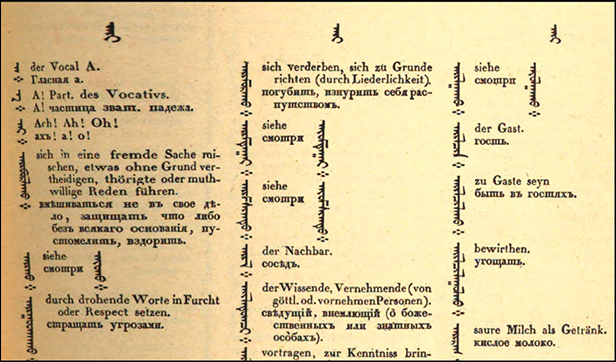
The expansion of the Russian Empire’s frontiers toward Manchu China meant interactions with several different Mongolic language groups that inhabit Siberia and the Far East, including Buryat and Oirat variants. The official Khalka dialect is prominent in the Republic of Mongolia. The 19th-century digitized book presented here is one of the earliest dictionaries of Mongolian language that was published by the Imperial Academy of Sciences in Saint Petersburg. We are highlighting this specific dictionary in consultation with the faculty members that teach and conduct their research in Mongolian. The scripts of the Mongolian language have evolved over the long history of the Mongols. Due to the Sovietization of Outer Mongolia, the alphabet was changed to Cyrillic characters (Khalkha) while the Inner Mongolia of the People’s Republic of China continued to use a variant of the traditional script which is called Uyghur-Mongolian.
Several UCB faculty members focus their research on Mongolia. Among them is Professor Emerita Patricia Berger, an art historian, and Professor Jacob Dalton, who is a world known specialist on Tibetan Buddhism. Tibetan Buddhism’s history and practice are syncretic to both past and present practice to the Buddhism of Mongolia. Brian Baumann is a lecturer of Mongolian language in East Asian Languages and Cultures and is instrumental in teaching language courses. Professor Sanjyot Mehendale, who teaches courses on Central Asia and the Silk Roads in the Department of Near Eastern Studies, is an archaeologist specializing in Eurasian trade and cultural exchange of the early Common Era. She has worked on several archaeology sites and projects in Central Asia, including Samarkand and Afghanistan.
The Mongolia collection has been developed to reconnect students with the history of Mongolia and the surrounding region. Besides students, the collection development revolves around the needs of faculty members and other scholars at UC Berkeley. Mongolia’s ethnic composition represents a unique tapestry of the Central Asian nationalities living within the geographic boundaries of the region along with the Mongols. The Department of East Asian Languages and Cultures offers courses related to Mongolia which vary from elementary Mongolian to Mongolian Buddhist Ritual (Buddhist Studies 190).[1] While the collection of Mongolian language books from the Republic of Mongolia printed in Cyrillic is approximately 1800 titles, Doe Library acquired nearly 800 new titles from 2009 through 2019. Besides, Mongolian language materials, we also have an extensive collection of books in Kazakh, Kyrgyz, Tajik, Turkmen and Uzbek languages.
As a librarian for East European and Central Asian Studies, I focused initially on collecting materials related to Buryat Mongols of Siberia. With a generous gift from the government of Mongolia, UC Berkeley and the Institute of East Asian Studies were delighted to announce the establishment of the Mongolia Initiative. This initiative led to the beginning of the teaching of Mongolian on campus for the first time in many years. Thus, the need for the collections of materials in Mongolian from the Republic of Mongolia became an ever-pressing reality. Since 2015, UC Berkeley has also received funding from the U.S. Department of Education to begin teaching elementary Mongolian. This National Resource Center grant recognizes UC Berkeley as a national leader for teaching and research on East Asia, including Mongolia.[2] It funds the education of lesser-taught world languages, in particular Mongolian, which is one of the critical languages for the national security of the United States government.[3]
Contribution by Liladhar Pendse
Librarian for the Mongolian Collections, Doe Library
Sources consulted:
- Mongolian (MONGLN) Berkeley Academic Guide – UCB (accessed 6/24/19)
- About the Mongolia Initiative, UC Berkeley (accessed 6/24/19)
- Languages of Interest, Central Intelligence Agency (CIA) (accessed 6/24/19)
~~~~~~~~~~
Title: Mongolisch-deutsch-russisches Wörterbuch : Nebst Einem Deutschen Und Einem Russischen Wortregister =: Mongolʹsko-ni︠e︡met︠s︡ko-rossīĭskīĭ Slovar : S Prisovokuplenīem Ni︠e︡met︠s︡kago I Russkago Alfavitnykh Spiskov.
Title in English: Mongolian-German-Russian Dictionary: In addition to a German and a Russian word index.
Author: Schmidt, Isaak Jakob, 1779-1847.
Imprint: Sanktpeterburg: Kaiserliche Akademie der Wissenschaften, 1835.
Edition: 1st.
Language: Mongolian Cyrillic (Khalkha)
Language Family: Mongolic
Source: HathiTrust Digital Library (UCLA)
URL: https://hdl.handle.net/2027/uc1.d0006851489
Other online editions:
- Bayerische Staatsbibliothek (BSB)
http://mdz-nbn-resolving.de/urn:nbn:de:bvb:12-bsb10691089-1
Print editions at Berkeley:
- Schmidt, Isaak J. Mongolisch-deutsch-russisches Wörterbuch: Nebst Einem Deutschen Und Einem Rusischen Wortregister. St. Petersburg: Bei den commissionairen der Kaiserlichen akademie der wissenschaften, W. Graeff und Glasunow, 1835.
The Languages of Berkeley is a dynamic online sequential exhibition celebrating the diversity of languages that have advanced research, teaching and learning at the University of California, Berkeley. It is made possible with support from the UC Berkeley Library and is co-sponsored by the Berkeley Language Center (BLC).
Follow The Languages of Berkeley!
Subscribe by email
Contact/Feedback
ucblib.link/languages
Mongolian
The Languages of Berkeley: An Online Exhibition

The Thousand Character Classic (Chinese: 千字文), also known as the Thousand Character Text, is one of the earliest and most widespread basic literacy texts for the study of classical Chinese. The rhyming text was composed by learned and talented scholar Zhou Xingsi of the Southern Liang dynasty (502-557) and has been used ever since as a primer for teaching Chinese characters to children. It contains exactly one thousand non-redundant characters arranged into 250 four-character couplets. Not only is the form succinct and poetic, but the text also imparts traditional Chinese knowledge and wisdom. It was widely circulated in ancient Japan, Korea, and Vietnam. It has also been translated into several western languages, including English, Latin, German, Italian, and French. The New Mongolian Translation of the Thousand Character Classic contains traditional Uyghur-Mongolian and Chinese text, as well as Manchu phonetic transcription. It is valuable for the study of Mongolian and Manchu phonology. The C.V. Starr East Asian Library owns a facsimile of the 1907 stone print edition. The original edition is held by the Harvard-Yenching Library and was recently digitized.
The course description for Mongolian 1A follows: “Mongolian is the language of a people who politically have emerged on the world stage after verily hundreds of years of imposed isolation, who geographically live on the vast open steppe that ranges from the Gobi to Siberia, who economically juggle an ancient tradition of pastoral nomadism with the development of national and private industry, who culturally know an eclectic, vibrant cosmopolitanism belied by their rugged open spaces, and who long ago established the largest contiguous empire the world has ever known.”[1] UC Berkeley has a long tradition of Mongolian Studies reaching back to the early 20th century. In 1935, Ferdinand Lessing, a German scholar of Central Asia, was named the fourth Agassiz Professor of East Asian Studies and established this country’s first course in the Mongolian language, as well as courses on Mongolia’s Buddhist tradition. He also published the first scholarly Mongolian-English dictionary in 1960.[2] Mongolian studies continued to advance under the direction of Professor James Bosson, who taught at Berkeley from 1964 through 1996. He was also a renowned scholar for the Manchu and Tibetan languages. Students at Berkeley begin with Khalkha Mongolian, the standard language of Mongolia, in its context as a dialect of Mongolian language proper using Cyrillic script and introducing traditional script. They then advance to Literary Mongolian, its phonetics, grammar, vertical writing system and its relation to living spoken language.
With a generous gift from the government of Mongolia, UC Berkeley and the Institute of East Asian Studies launched the Mongolia Initiative in 2016. Mongolian is now being taught on campus for the first time in many years by Professor Brian Baumann who concentrates on Mongolian texts on Buddhism, history and culture. Funding from the U.S. Department of Education has also supported the language program and other research activities on Mongoliat as well as for enrichment of the Mongolian collection in the Library.
Contribution by Jianye He
Librarian for the Chinese Collections, C.V. Starr East Asian Library
Sources consulted
~~~~~~~~~~
Title: 新譯蒙漢千字文 = Sin-e orčiγuluγsan mongγol irgen mingγan üsüg bui
Title in English: The New Mongolian Translation of the Thousand Character Classic
Author: Zhou, Xingsi, d. 521.
Imprint: Beijing : Zhen bei shi yin guan, Guangxu ding wei, 1907.
Edition: n/a
Language: Mongolian
Language Family: Mongolic
Source: Harvard College Library Harvard-Yenching Library
URL: http://nrs.harvard.edu/urn-3:FHCL:10443432
Print editions at Berkeley:
- Facsimile reprint has been published in volume one of 清代蒙古文啓蒙讀物薈萃 = Qing dai Menggu wen qi meng du wu hui cui. Huhehaote Shi : Yuan fang chu ban she, 2016.
The Languages of Berkeley is a dynamic online sequential exhibition celebrating the diversity of languages that have advanced research, teaching and learning at the University of California, Berkeley. It is made possible with support from the UC Berkeley Library and is co-sponsored by the Berkeley Language Center (BLC).
Follow The Languages of Berkeley!
Subscribe by email
ucblib.link/languages
Tibetan
The Languages of Berkeley: An Online Exhibition
Rgyal rabs gsal ba’i me long is a famous historical work by Sakyapa Sonam Gyaltsen (1312-1375). The text presents Tibetan history such as the origins of the Tibetans, how dharma arrived in Tibet, when Lhasa became the main capital and the Jokhang and Ramoche temples were built. Sakyapa Sonam Gyaltsen was a ruler of Sakya which had a preeminent position in Tibet under the Yuan dynasty. He is considered the greatest Sakya scholar of the 14th century and served as ruler for a short term from 1344 to 1347.
According to McComas Taylor who authored the English translation, “It ranks among the great works of early Tibetan historiographical writing, but outshines all others in both the depth and breadth of its coverage. . . The text is a rich blend of history, legend, poetry, adventure and romance. It may properly be regarded as a literary work, albeit a morally and spiritually uplifting one.” He writes further: “This text has been known by several names. The original Tibetan title, and the one that is most widely recognized, is Clear Mirror on Royal Genealogy, although in the final paragraph the author himself calls the work Clear Mirror on the History of the Dharma. The first wood-block edition was printed at the Tsuglagkhang in 1478 and is therefore known as the Lhasa redaction.”
Ever since China annexed Tibet as a province in 1951, the Tibetan language has been proscribed in schools in favor of Mandarin.[1] Tibetan Buddhism and its literature are thus at present maintained by a worldwide diaspora, drawing some strength from Tibetan communities of the southern Himalaya beyond the Chinese border.[2] There are numerous (and mutually unintelligible dialects) of modern spoken Tibetan, and the study of these dialects — essential for the study of cultural practices such as pilgrimage — is becoming an area of research at several institutions, including UC Berkeley.[3] This historical text has been translated into Mongolian, German, and Chinese, and various sections have appeared in Italian and Russian.
Contribution by Susan Xue
Head, Information and Public Services &
Electronic Resources Librarian, C.V. Starr East Asian Library
Sources consulted:
- Garry, Jane, and Carl R. G. Rubino. Facts About the World’s Languages: An Encyclopedia of the World’s Major Languages, Past and Present. New York: H.W. Wilson, 2001.
- May, Stephen. Language and Minority Rights: Ethnicity, Nationalism and the Politics of Language. New York: Routledge, 2012.
- Institute for South Asia Studies, UC Berkeley
~~~~~~~~~~
Title: Rgyal rabs gsal ba’i me long
Title in English: Clear Mirror on Royal Genealogy
Author: Bsod-nams-rgyal-mtshan, Sakyapa Sonan Gyaltsen, 1312-1375.
Imprint: Pe cin: mi rigs dpe skrun khang, 2002.
Edition: Par gzhi 1
Language: Tibetan
Language Family: Sino-Tibetan
Source: Buddhist Digital Resource Center
URL: https://www.tbrc.org/#!rid=W00KG09730
Select print editions at Berkeley:
- Bsod-nams-rgyal-mtshan, Sakyapa Sonan Gyaltsen, and B I. Kuznet︠s︡ov, ed. Rgyal Rabs Gsal Baʼi Me Long: The Clear Mirror of Royal Genealogies ; Tibetan Text in Transliteration with an Introduction in English. Leiden: Brill, 1966.
- Bsod-nams-rgyal-mtshan, Sakyapa Sonan Gyaltsen. Translated into English by McComas Taylor, and Yuthok Choedak. The Clear Mirror: A Traditional Account of Tibet’s Golden Age. Ithaca, NY: Snow Lion Publications, 1996. Preview in Google Books.
- Bsod-nams-rgyal-mtshan, Sakyapa Sonan Gyaltsen. Translated into Chinese by Liqian Liu. Xizang Wang Tong Ji. Beijing Shi: Min zu chu ban she, 2000.
The Languages of Berkeley is a dynamic online sequential exhibition celebrating the diversity of languages that have advanced research, teaching and learning at the University of California, Berkeley. It is made possible with support from the UC Berkeley Library and is co-sponsored by the Berkeley Language Center (BLC).
Follow The Languages of Berkeley!
Subscribe by email
Contact/Feedback
ucblib.link/languages
Armenian
The Languages of Berkeley: An Online Exhibition

At the request of the Librarian for the Armenian Studies, Liladhar Pendse, we are posting this entry on April 22nd in the memory of the victims of Armenian Genocide. The 24th of April is Armenian Genocide Remembrance Day. The resilience of the Armenian nation, language and culture exemplify a human desire to overcome destruction and create literary monuments.
Armenian scholar and official at the court of King Vramshapuh, Mesrop Mashtots (Մեսրոպ Մաշտոց) invented the Armenian alphabet in 405 CE. Today, Western Armenian is one of the two standardized forms of Modern Armenian, the other being Eastern Armenian. Until the early 20th century, various Western Armenian dialects were spoken in the Ottoman Empire, especially in the eastern regions of the empire historically populated by Armenians and which are known as Western Armenia. Western Armenian language is also spoken in France and in the diaspora of Armenians in the United States. On the other hand, Eastern Armenian is spoken in Armenia, Artsakh, Republic of Georgia, and in the Armenian community in Iran. The two Armenian standards together form a pluricentric language. Nevertheless, only Western Armenian is considered one of the endangered languages by the UNESCO.
In the late 1980s, a group of Bay Area Armenian-American visionaries decided to introduce the concept of Armenian Studies at one of the most renowned universities in the world — the University of California, Berkeley. Within a few years, under the leadership of the UC Berkeley Armenian Alumni, and thanks to the remarkable mobilization of the community and generosity of major donors, the William Saroyan Visiting Professorship in Modern Armenian Studies was established. Later the Krouzian Endowment, established in 1996, would provide this position with significant additional support. In the fall of 1998, the William Saroyan Visiting Professorship became a full-time position.
Professor Stephan Astourian was appointed Executive Director of the Armenian Studies Program and Assistant Adjunct Professor of History in July 2002. The William Saroyan position was no longer dependent on temporary appointments. Professor Astourian began to build the foundation of a full-fledged academic program focused on contemporary Armenian history, politics, language, and culture. The program now offers Armenian history Armenian that is further enriched by visiting scholars, academic conferences, symposia, and public speaking engagements organized or delivered by Professors Astourian and Douzjian.
Shahan Shahnur’s Retreat Without Song was serialized in the Paris daily Haraj (Onward) before it was published as a novel in 1929. Set in Paris, the novel traces a tempestuous love story that provokes an identity crisis in the main character. While the interethnic romance between an Armenian man and a French woman drives the novel’s plot, its setting and characterization foreground the challenges Armenians faced after their exile from Istanbul, in the aftermath of the genocide. Upon publication, the novel enjoyed immediate success among readers; however, conservative critics, appalled by its violation of cultural taboos, labeled it pornographic. Today, precisely for its provocative treatment of religious values, romance, and diasporic life, Retreat Without Song rightfully occupies a place among the foundational texts of modern Western Armenian literature.
Hovhannes Tumanyan’s artful Eastern Armenian verse, unanimously loved by readers for over a century, presents cultural wisdom and a witty, critical perspective on socio-political dynamics. This collection includes two narrative poems that inspired operas: the tragic love story depicted in Anush served as the libretto for Armen Tigranyan’s homonymous opera whereas The Capture of Fort Temuk, a historical tale of political intrigue, was the basis for Alexander Spendiaryan’s Almast. Also notable in this collection, David of Sasun is based on the third cycle of the Armenian epic Daredevils of Sasun. A remarkable piece of literature, this epic circulated orally for almost a millennium until its first transcription in 1873, which in turn paved the way for studies and transcriptions of additional variants. Tumanyan’s verse adaptation of this epic, first published in 1904 and still widely read, bespeaks the poet’s mastery of folkloric style.
Contribution by Stephan Astourian & Myrna Douzjian
Faculty, Armenian Studies Program
Liladhar Pendse, Librarian for Armenian Studies, Doe Library
Title: Nahanjě aṛantsʻ ergi
Title in English: Retreat Without Song
Author: Shahnur, Shahan, 1903-1974
Imprint: Serialized for the daily newspaper Haraj =Haratch (Paris: Imp. Araxes, 1925-?).
Edition: Unknown
Language: Eastern Armenian
Language Family: Indo-European, Armenian
Source: Digital Library of Armenian Literature
URL: http://www.digilib.am/book/882/Երկեր%20թիւ
Print editions in Library:
- Sessiz ricat : resimli Ermeni tarihi = Nahanjě aṛantsʻ ergi = Silent Retreat = Retreat Without Song / Şahan Şahnur ; Ermeniceden çevirenler Maral Aktokmakyan, Artun Gebenlioğlu. Beyoğlu, İstanbul : Aras, 2016.
- Retreat Without Song / Shahan Shahnour ; translated from the Armenian and edited by Mischa Kudian. London : Mashtots Press, 1982.
Title: Banasteghtsutʻiwnner
Title in English: Selected Poems
Author: Tʻumanyan, Hovhannes, 1869-1923
Imprint: Kostandnupolis : Tpagrutʻiwn K. Kʻēshishean Ordi, 1922.
Edition: 1st edition
Language: Eastern Armenian
Language Family: Indo-European, Armenian
Source: HathiTrust Digital Library (UCLA)
URL: https://hdl.handle.net/2027/uc1.l0081024747
The Languages of Berkeley is a dynamic online sequential exhibition celebrating the diversity of languages that have advanced research, teaching and learning at the University of California, Berkeley. It is made possible with support from the UC Berkeley Library and is co-sponsored by the Berkeley Language Center (BLC).
Follow The Languages of Berkeley!
Subscribe by email
Contact/Feedback
ucblib.link/languages
![The Languages of Berkeley [fan]](https://update.lib.berkeley.edu/wp-content/uploads/2019/02/fan_languages-450px.jpg)
